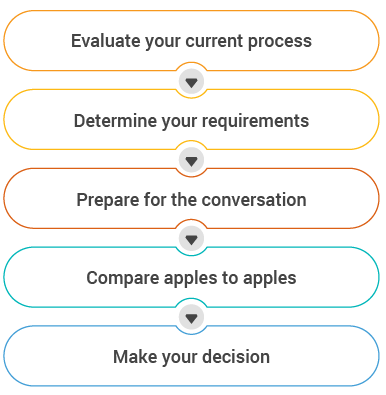EDC is a critical system in your clinical trial,
involving many stakeholders.
But selecting an EDC can feel overwhelming, and the information from vendors can start to sound the same. With help from Bioforum the Data Masters, a data-driven CRO, we’ve put together a step-by-step guide to help choose the EDC that’s right for your study. This resource is tailored for data managers and supporting teams at small to mid-size biopharmas in charge of selecting an EDC vendor.
5 Steps for a Successful EDC


Step 1
Evaluate your current process
What are the current challenges and limitations of your existing system? Is there anything missing that would be nice? Key areas to focus on:
- Study build effort: Is your team able to meet timelines comfortably? If not, is it due to missing functionality or shortcomings in the system?
- Administration: Is it easy to provide access to users?
- Customizations: Do you need lots of workarounds or custom functions to support your studies?
- Flexibility: How flexible is your system when you need to incorporate protocol amendments, and how much downtime is required?
- Access to Data: Can you see reports and dashboards of operational metrics as well as easily access clinical data?
Ask sites and CROs for their input. You can create a short survey to learn about their pain points. This will help you make the right choice and ease user-adoption.
Step 2
Determine your requirements
Your therapeutic area and protocol requirements will dictate many of the functions you need.
- Prioritize improvements: Determine the most important improvements you are trying to make (study build times, the time it takes to do an amendment, LPLV to database lock, etc.)
- Establish KPIs: What are you trying to solve or improve? How do you measure success? Build those KPIs into your requirements.
- Define data collection: Consider other data you are collecting (IRT, eCOA, etc.) and how you want that to integrate with your EDC data.
- Create a wish list: List anything that would improve your current process even if you don’t think it’s possible.
Step 3
Prepare for the conversation
The focus of the meeting should be on your requirements. Assume the vendor can handle the basics and spend the meeting digging deeper into your critical functionality.
- Send a list of requirements in advance: This allows the vendor to prepare and align the demo with what’s most important to you.
- Provide protocols: Give the vendor a protocol that’s similar to the ones that you have planned moving forward and then ask them to demonstrate those key scenarios.
- Set a meeting agenda: Ensure the vendor will cover the areas and features important to you and send this out in advance.
Often, data management teams have straight-forward questions but can get put off-track by technical lingo or vague responses. See this sample question guide for pointed questions to help.
Step 4
Compare apples
to apples
Pick a challenging but realistic scenario and then ask each vendor to demo how they would handle this activity, not just speak to it in theory.
Conversation starters:
- "How does data integrate with the EDC – both inbound (IRT to EDC) and outbound (EDC to CTMS, for example)?"
- "How do you handle amendments?" Think of a specific amendment that caused a lot of trouble for your team. Present the scenario to the vendor and have them demonstrate how the system would handle that. You could face extensive downtime and fragile data migrations if you don't do a thorough evaluation of a system’s amendment capability.
- "What are the top 3-5 enhancements that have improved data management processes?" Also, ask for a roadmap discussion and seek to understand how customers contribute to it and new features are prioritized.
NOTE: If you work with a CRO and things get technical, bring them into the conversation to help interpret the conversation.
Consider a workshop rather than working in a sandbox, which will take time to learn no matter how intuitive. During the workshop, have the vendor use a protocol similar to the ones that you have planned moving forward and demonstrate how to build the study, make amendments, handle your complex forms, etc.
Step 5
Make your decision
Use these four guidelines to weigh the pros and cons of each vendor.
- Determine price: Drill into license costs: is it a complete license cost or will the vendor charge extra for things like a targeted SDV approach or using a local labs functionality?
- Check references: Ask for a customer reference and have a one-on-one conversation without the vendor so you can speak candidly.
- Understand the CRO partnership: Which CROs does the vendor work with and how does that partnership work? Ask about the onboarding process, training, ongoing support model, etc.
- Get stakeholder agreement: Once you have got a clear choice in mind, inform your CRO of your decision. As a sponsor, you have the right to work with the EDC that best meets your needs.
When considering the price, be wary that what you may save initially, you might end up spending on builds and amendments if the system isn't easy to use or requires manual workarounds.
Agile Design for EDC
Agile Design is a new approach to building studies and addresses challenges throughout the traditional build process. The technology and process improvements within Agile Design make it easy to build complex studies, iterate quickly, and deploy updates, which helps your study team become nimble and more successful.
Tanya du Plessis, VP, Data Strategies and Solutions at Bioforum shares the advantages of an agile design approach to building studies.



Learn how an Agile Design approach can help your team achieve
shorter builds, easier amendments, and faster locks.
Contact Us